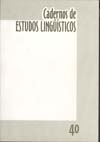Resumen
A model of speech rhythm production is proposed that is able to explain the differences found between the durational patterns of stress- and syllable-timed languages from strict considerations of timing. This is possible from a two-parameter characterization of Brazilian Portuguese V-to-V duration patterns within stress groups. The parameters are speech rate (measured in terms of V-to-V units per unit of time) and the coupling strength between two oscillators (syllabic and stress group oscillators), which act as a cognitive pacemaker whose pace is the vowel onset succession entrained by the beats of the stress group oscillator. Differences in amount of coupling strength seem to explain differences in rhythmic typology. A link with lexical processing is also suggested here.Citas
ABERCROMBIE, D. (1967). Elements of General Phonetics. Edinburgh: Edinburgh University Press.
ALBANO, E. C. (2001). O Gesto e suas Bordas: por uma fonologia acústico-articulatória do português brasileiro. Campinas: Mercado de Letras.
BARBOSA, P. A. (2000). “Syllable-timing in Brazilian Portuguese”: uma crítica a Roy Major. D.E.L.T.A., 16 (2), 369-402.
BARBOSA, P. A. (2001). “Generating Duration from a Cognitively Plausible Model of Rhythm Production”. Proceedings of the Seventh European Conference on Speech Communication and Technology (Eurospeech 2001), Aalborg, Dinamarca, 3-7 setembro, v. 2, 967-970.
BARBOSA, P. A. (submetido). O Universal e o Específico a Língua em um Modelo Dinâmico de Produção do Ritmo (Fonético e Fonológico) da Fala. Anais do II Congresso Internacional da Abralin, 14 a 16 de março, Fortaleza, Ceará.
BARBOSA, P. A. & S. MADUREIRA. (1999). Toward a hierarchical model of rhythm production: evidence from phrase stress domains in Brazilian Portuguese. Proceedings of the XIVth International Congress of Phonetic Sciences, 1: 297-300.
BERTINETTO, P.M. (1989). Reflections on the dichotomy “stress-” vs “syllable-timing”. Revue de Phonétique Appliquée, 91-92-93: 99-130.
BROWMAN, C. & GOLDSTEIN, L. (1989). Articulatory Gestures as Phonological Units. Phonology, 6: 201-251,.
BERTINETTO, P.M. (1990). Tiers in Articulatory Phonology with some implications for casual speech. In: KINGSTON, J. & BECKMAN, M.E. (Eds.) Papers in Laboratory Phonology I. Cambridge: Cambridge University Press, 341-376.
BERTINETTO, P.M. (1992). Articulatory Phonology: an overview. Phonetica, 49: 155-180.
CHISTOVICH, L.A. & E.A. OGORODNIKOVA. (1982). Temporal processing of spectral data in vowel perception. Speech Communication, 1: 45-54.
DAUER, R.M. (1983). Stress-timing and syllable-timing re-analysed, Journal of Phonetics, 11: 51-62.
FANT, G. & A. KRUCKENBERG. (1989). Preliminaries to the study of Swedish prose reading and reading style. Quarterly Progress and Status Report, Speech Transmission Laboratory, KTH, 2: 1-83.
JANKER, P. (1995). On the influence of the internal structure of a syllable on the P-center perception. Proceedings of the XIIIth International Congress of Phonetic Sciences, 2: 510-513.
LEA, W.A. (1974). Prosodic aids to speech recognition: IV. A general strategy for prosodically-guided speech understanding. Univac Report PX10791, Sperry Univac, DSD, St. Paul, Minnesota, EUA.
LEHISTE, I. (1977). Isochrony reconsidered. Journal of Phonetics, 5: 253-263.
LLOYD-JAMES, A. (1940). Speech signals in Telephony. London.
MARCUS, S. M. (1976) Perceptual-centres. Tese de Doutorado Inédita. Cambridge: Cambridge University.
NOOTEBOOM, S.G. (1991). Some observations on the temporal organisation and rhythm of speech. Proceedings of the XIIth International Congress of Phonetic Sciences, 1: 228-237.
O’DELL, M. & T. NIEMINEN. (1999). Coupled oscillator model of speech rhythm. Proceedings of the XIVth International Congress of Phonetic Sciences, 2: 1075-1078.
PIKE, K. (1945). The Intonation of American English. Ann Arbor: University of Michigan Press.
POMPINO-MARSCHALL, B. (1989). On the psychoacoustic nature of the p-center phenomenon. Journal of Phonetics, 17: 175-192.
POMPINO-MARSCHALL, B. (1991). The syllable as a prosodic unit and the so-called p-centre effect. Forschungsberichte der Institut für Phonetik und Sprachliche Kommunikation der Universität München, 29: 66-124.
ROACH, P. (1982). On the distinction between ‘stress-timed’ and ‘syllable-timed’ languages. In: CRYSTAL, D. (Ed.) Linguistic controversies. Essays in linguistic theory and practice in honour of F. R. Palmer. Londres: Edward Arnold, 73-79.
STROGATZ, S. & I. STEWART. (1994). Oscillateurs couplés et syncronisation biologique. Pour la Science, 196: 40-46.
TURK, A. (1994). Articulatory phonetic clues to syllable affiliation: gestural characteristics of bilabial stops. In: KEATING, P. A. (Ed.) Phonological Structure and Phonetic Form: Papers in Laboratory Phonology III. Cambridge, UK: Cambridge University Press.
VAISSIÈRE, J. (1983). Language-independent prosodic features. In: Prosody: models and measurements. Cutler, A. and Ladd, D.R. (Eds.) Berlin: Springer-Verlag, 53-66.
Se otorgan a la Revista CADERNOS DE ESTUDOS LINGÜÍSTICOS todos los derechos de autor relativos a los trabajos publicados. No se devolverán los originales. En virtud de su aparición en esta revista de acceso abierto, los artículos son de uso gratuito, con la debida atribución, en aplicaciones educativas y no comerciales.

